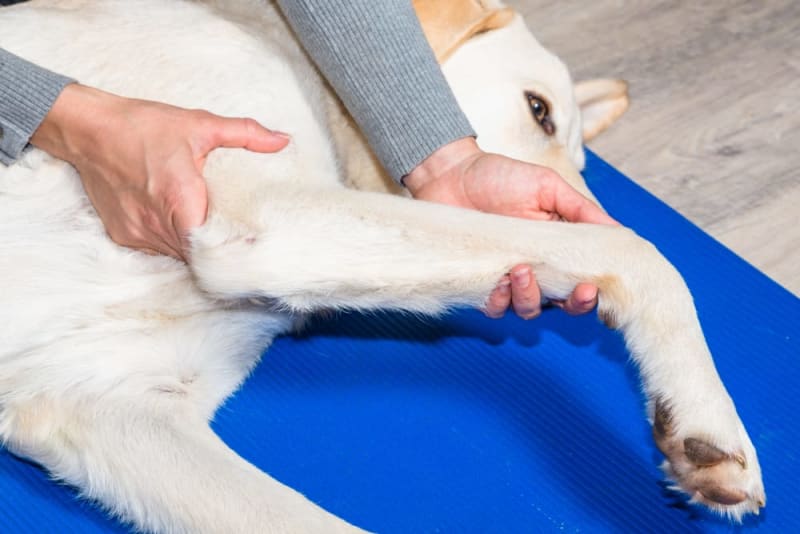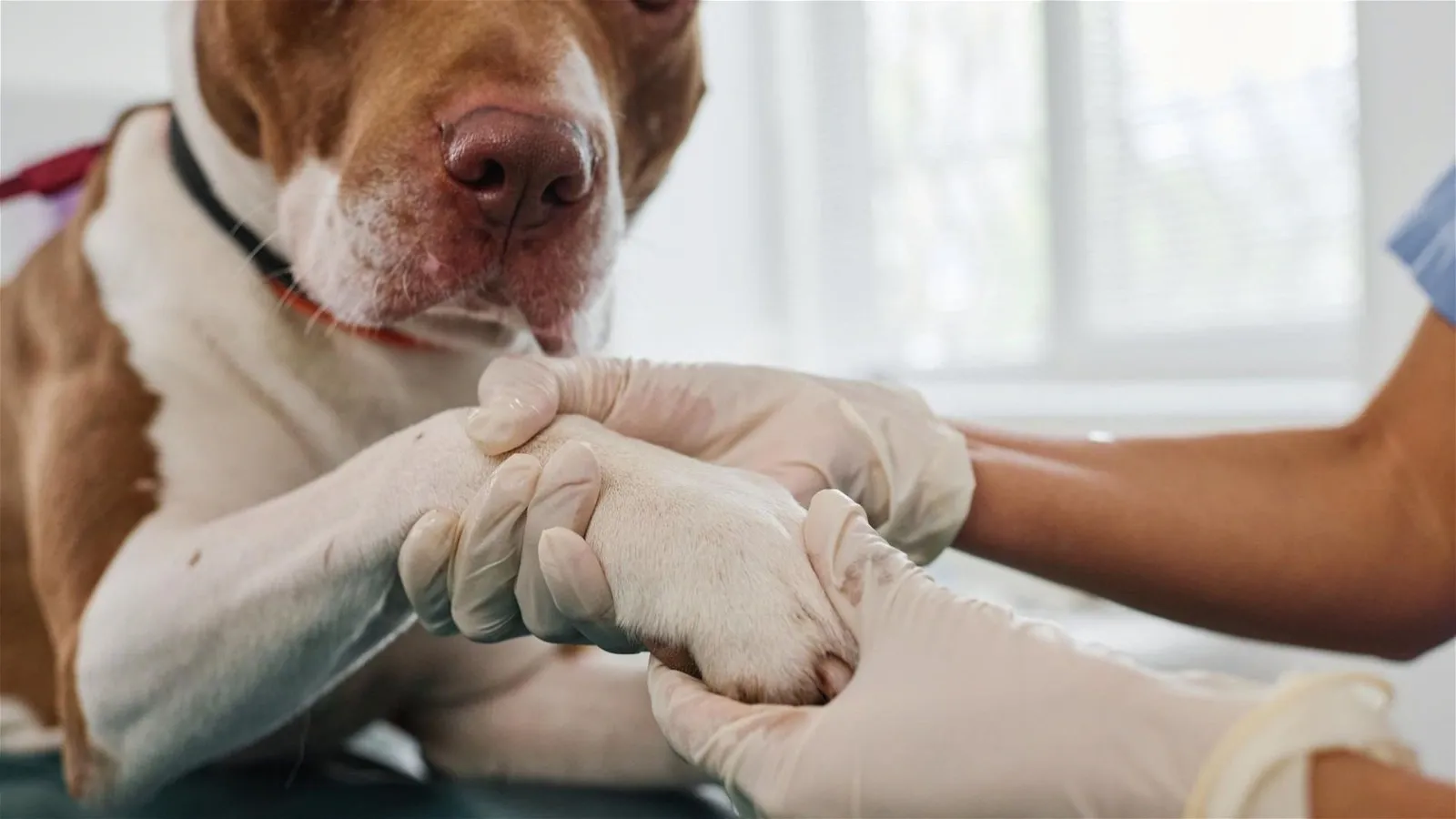Arthritis and joint pain are common conditions in dogs, especially as they age. These conditions can cause discomfort, pain, and even mobility issues for our furry friends. As a dog owner, it's crucial to understand how to manage arthritis and joint pain in your dog to improve their quality of life.

One of the most critical steps in managing arthritis and joint pain in dogs is recognizing the signs and symptoms. These can include limping, stiffness, reluctance to move, and difficulty getting up or lying down. If you notice any of these signs, it's essential to bring your dog to the veterinarian for an evaluation and diagnosis. With proper treatment and management, many dogs with arthritis and joint pain can continue to lead happy and active lives.
Understanding Arthritis in Dogs
Arthritis is a common condition that affects dogs of all ages and breeds. It is a degenerative joint disease that causes inflammation and pain in the joints. Arthritis can be a result of various factors such as aging, genetics, obesity, and injury.

Types of Arthritis
Different types of arthritis can affect dogs. The most common types are osteoarthritis, rheumatoid arthritis, and septic arthritis. Osteoarthritis is the most common type and is caused by wear and tear on the joints over time. Rheumatoid arthritis is an autoimmune disease that causes the immune system to attack the joints. Septic arthritis is caused by a bacterial infection in the joints.
Causes of Joint Pain
Joint pain in dogs can be caused by a variety of factors such as injury, overuse, and arthritis. Injuries such as fractures and ligament tears can cause joint pain. Overuse of joints can also cause pain and inflammation. Arthritis is a common cause of joint pain in dogs and can be caused by various factors such as aging, genetics, and obesity.
Signs and Symptoms
The signs and symptoms of arthritis in dogs include stiffness, limping, difficulty getting up or lying down, decreased activity, and reluctance to climb stairs or jump. Some dogs may also show signs of pain such as whimpering or yelping when touched or moved. It is significant to take note of these signs and symptoms and consult a veterinarian if they persist.
Hence, understanding arthritis in dogs is crucial in managing joint pain and improving their quality of life. By identifying the type of arthritis, causes of joint pain, and signs and symptoms, pet owners can take appropriate measures to manage the condition and provide their furry friends with the care they need.
Diagnosing Canine Arthritis
Arthritis is a common condition in dogs, especially as they age. It can be challenging to diagnose early on because dogs are masters at hiding their pain. However, with the right veterinary examination, imaging techniques, and laboratory tests, it is possible to determine if your dog has arthritis.
Veterinary Examination
A thorough veterinary examination is the first step in diagnosing canine arthritis. During the examination, the veterinarian will look for signs such as joint swelling, stiffness, and pain. They may also manipulate your dog's joints to assess their range of motion and any discomfort they may be experiencing.
Imaging Techniques
Imaging techniques such as X-rays, CT scans, and MRI scans can provide valuable information about the condition of your dog's joints. X-rays can show changes in bone density and joint structure, while CT and MRI scans can reveal soft tissue damage. These imaging techniques can help your veterinarian determine the severity of your dog's arthritis and develop an effective treatment plan.
Laboratory Tests
Laboratory tests can also be useful in diagnosing canine arthritis. Blood tests can help identify underlying conditions that may be contributing to your dog's joint pain, such as Lyme disease or autoimmune disorders. Analysis of joint fluid can also provide valuable information about the condition of your dog's joints and help determine the best course of treatment.
Thus, diagnosing canine arthritis requires a combination of veterinary examination, imaging techniques, and laboratory tests. With the right diagnosis, you and your veterinarian can develop an effective treatment plan to help manage your dog's joint pain and improve their quality of life.
Managing Arthritis Pain
Arthritis can cause chronic pain and discomfort for dogs, making it difficult for them to move around and enjoy their daily activities. Fortunately, there are several ways to manage arthritis pain in dogs.
Pain Relief Medications
Non-steroidal anti-inflammatory drugs (NSAIDs) are commonly prescribed by veterinarians to manage arthritis pain in dogs. These drugs work by reducing inflammation and pain in the affected joints. However, it is important to use these medications with caution and under the guidance of a veterinarian, as they can have potential side effects such as stomach ulcers and liver or kidney damage.
Supplements and Nutraceuticals
Supplements and nutraceuticals can also be effective in managing arthritis pain in dogs. Glucosamine and chondroitin are two popular supplements that can help improve joint health and reduce inflammation. Omega-3 fatty acids, found in fish oil, can also have anti-inflammatory effects.
Other supplements and nutraceuticals that may be beneficial for dogs with arthritis include:
- Turmeric: a natural anti-inflammatory
- MSM: a source of sulfur that can help reduce inflammation and pain
- Green-lipped mussel: contains omega-3 fatty acids and other anti-inflammatory compounds
It is essential to note that supplements and nutraceuticals are not regulated by the FDA. It is required to choose products from reputable manufacturers and consult with a veterinarian before starting any new supplement regimen.
By using a combination of pain relief medications and supplements/nutraceuticals, dog owners can help manage their pet's arthritis pain and improve their overall quality of life.
Lifestyle and Home Remedies

Weight Management
Maintaining a healthy weight is crucial for dogs with arthritis as excess weight puts extra pressure on the joints. A balanced diet, portion control, and regular exercise can help manage a dog's weight. Consult with a veterinarian to determine the ideal weight for the dog and to develop a diet and exercise plan.
Exercise and Physical Therapy
Exercise and physical therapy can help maintain joint mobility and reduce pain. Low-impact exercises such as walking, swimming, and gentle stretching can help improve a dog's flexibility and range of motion. Physical therapy, such as massage and hydrotherapy, can also help relieve pain and stiffness. Consult with a veterinarian or a certified canine rehabilitation therapist to develop an exercise and physical therapy plan tailored to the dog's specific needs.
Comfortable Bedding
Providing a comfortable bed can help reduce joint pain and stiffness. Orthopedic beds or beds with memory foam can help distribute the dog's weight evenly and reduce pressure on the joints. Adding extra padding or blankets can also provide additional comfort. It is needed to ensure that the bed is easily accessible and not too high off the ground, especially for older dogs with mobility issues.
By incorporating these lifestyle and home remedies, dog owners can help manage their dog's arthritis and joint pain and improve their overall quality of life.
Advanced Treatments and Therapies
Surgical Options
Surgery is typically considered a last resort for managing arthritis and joint pain in dogs. However, in severe cases, it may be the best option. The most common surgeries for arthritis and joint pain in dogs include total joint replacement and arthroscopy. These surgeries can be expensive, but they can provide significant pain relief and improved mobility.
Regenerative Medicine
Regenerative medicine is a relatively new field that involves using the body's cells to promote healing and repair. One regenerative medicine option for dogs with arthritis and joint pain is stem cell therapy. It involves extracting stem cells from the dog's own fat tissue or bone marrow and injecting them into the affected joint. Another option is platelet-rich plasma therapy, which involves using the dog's blood to promote healing.
Alternative Therapies
In addition to traditional treatments, several alternative therapies can help manage arthritis and joint pain in dogs. These include:
- Acupuncture: This ancient Chinese therapy involves inserting small needles into specific points on the body to stimulate healing and reduce pain.
- Massage: Gentle massage can help improve circulation and reduce muscle tension, which can help ease joint pain.
- Supplements: Several supplements may help manage arthritis and joint pain in dogs, including glucosamine, chondroitin, and omega-3 fatty acids.
It's important to note that while these alternative therapies may provide some relief, they should not be used as a substitute for traditional treatments. Always consult with a veterinarian before starting any new therapy or treatment plan.
Preventing Joint Problems
Arthritis and joint pain are common disorders in dogs, especially as they age. While some factors contributing to joint problems are beyond an owner's control, some steps can be taken to help prevent joint problems from developing or worsening. Here are some key considerations:
Nutrition and Diet
Maintaining a healthy weight is crucial for preventing joint problems in dogs. Excess weight puts additional strain on joints, increasing the likelihood of damage and inflammation. A balanced diet that includes appropriate amounts of protein, fat, and carbohydrates can help keep dogs at a healthy weight and support joint health. Some foods and supplements, such as omega-3 fatty acids and glucosamine, may also be beneficial for joint health.
Regular Check-Ups

Regular veterinary check-ups are crucial for catching joint problems early and preventing them from worsening. During routine visits, a veterinarian can examine a dog's joints for signs of inflammation, pain, or stiffness. They may also recommend X-rays or other diagnostic tests to assess joint health. Catching joint problems early can help prevent irreversible damage and make treatment more effective.
Breed-Specific Considerations
Certain dog breeds are more prone to joint problems than others. For example, large breeds such as Great Danes and Saint Bernards are at higher risk for hip dysplasia, an issue in which the hip joint doesn't form properly. Owners of these breeds should take extra care to prevent joint problems by maintaining a healthy weight, providing appropriate exercise, and working with a veterinarian to monitor joint health. Other breeds may be prone to different joint concerns, so it's significant to research breed-specific considerations and talk to a veterinarian about how to prevent joint problems in your dog.
By taking these steps, owners can help reduce the likelihood of joint problems in their dogs and promote overall joint health. With proper care, dogs can lead happy, active lives even as they age.
Final Thought

Managing arthritis and joint pain in dogs needs a comprehensive approach, combining diet, exercise, medication, and alternative therapies. By staying proactive and attentive to your dog's needs, you can significantly improve their quality of life. Remember, your vet is your best ally in managing this illness, so routine check-ups and open communication are essential.
Frequently Asked Questions
- Q1: What are the signs that a dog may be suffering from arthritis?
- A1: Dogs suffering from arthritis may show signs such as limping, stiffness, reluctance to jump or climb stairs, and difficulty getting up or lying down. They may also show signs of pain, such as whining, whimpering, or licking the affected joint.
- Q2: How can I make my home more comfortable for a dog with arthritis?
- A2: To make your home more comfortable for a dog with arthritis, you can provide soft bedding, non-slip flooring, and ramps or steps to help them navigate stairs and furniture. You can also raise their food and water bowls to reduce strain on their neck and back.
- Q3: What are some effective home remedies for managing joint pain in dogs?
- A3: Some effective home remedies for managing joint pain in dogs include providing a healthy diet, regular exercise, and supplements such as glucosamine and chondroitin. You can also apply heat or cold therapy to the affected joint, and provide massage or physical therapy.
- Q4: Which medications are commonly prescribed for dogs with arthritis?
- A4: Commonly prescribed medications for dogs with arthritis include non-steroidal anti-inflammatory drugs (NSAIDs), corticosteroids, and disease-modifying anti-rheumatic drugs (DMARDs). Your veterinarian can help determine the best medication for your dog's specific needs.
- Q5: How does diet influence arthritis symptoms in dogs?
- A5: A healthy diet can help reduce inflammation and manage arthritis symptoms in dogs. Foods high in omega-3 fatty acids, such as fish and flaxseed, can help reduce inflammation. Additionally, maintaining a healthy weight can reduce stress on the joints.




